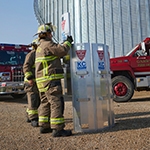Prevent poultry building fires
Follow these tips to help reduce loss from fire.
One of the ways Nationwide supports its members is by maintaining an extensive database of losses, including causes when they are identifiable. This database enables Nationwide to identify trends and offer insights to members to help prevent losses, including the loss of poultry buildings due to fires.
In the poultry-rich Delmarva region, for instance, loss data shows a direct correlation between the age of a poultry building and the potential for a total loss fire. Data for this region — which includes part of Delaware, Maryland and Virginia — show that fire was the cause of loss in 75% of cases for poultry buildings 20 years old or older, and in 25% of cases for buildings 10 to 15 years old.
Although the cause of a fire is often documented as "unknown," data show that the primary drivers for total-loss fires for poultry houses are a condition of the electrical or heating/gas systems.
Electrical fires
In the Delmarva region, electrical fires have been the #1 cause of poultry building fire losses. Here are some questions that may help you reduce fire losses.
How old is your building's electrical system?
- Once the electrical system reaches 15 years of use, have your electrical system inspected annually by a qualified electrician. Make any updates or recommended repairs.
- When installing new equipment (fans, cool cells, feed lines, etc.) to an existing electrical system, be sure to check capacities. Also consider updating the entire electrical system.
The electrical system should be installed per National Electric Code (NEC) Article 547 for Poultry Confinement Buildings. Basic standards include the following:
- Electrical wiring should be in PVC conduit or UF (Underground Feeder) cable.
- Electrical boxes, fittings, controls and switchgear should be corrosion-resistant, dust-tight and watertight.
- Light fixtures should be corrosion-resistant, dust-tight and watertight.
- Electric motors should be Totally Enclosed, Fan Cooled (TEFC).
Learn more about National Electrical Code (NEC) Article 547.
Is electrical entrance or service panel located outside the corrosive confinement environment?
Ideally, circuit breakers should be located outside confinement buildings or moved when there is an opportunity to relocate. In situations where circuit breakers are installed inside poultry confinement buildings, they should be:
- Located in a separate room away from the corrosive environment of the poultry area.
- Completely replaced every 15 years. Standard circuit breakers are not sealed from vapors and gases in their environment. The caustic atmosphere of the confinement building leads to deterioration of the electromagnet and steel trip mechanism inside, which reduces the likelihood they will trip in an overloaded condition.
Does your poultry building have permanently wired cords?
Permanently wired cords are problematic because, over time, the vibration from equipment or the repetitive physical manipulation of the cord breaks down the insulation covering the conductors. When the insulation breaks down, it creates an area where arc faulting occurs. Standard circuit breakers are insensitive to detecting arc faulting and will not de-energize a circuit where arc faulting is occurring.
Common areas where permanently wired cords tend to be installed include:
- Ventilation fan motors where a permanent cord runs between the motor and a switch or outlet.
- Somewhere close to the cranking mechanism for the equipment winching system. (Often, a convenience outlet is installed here to operate an electric drill to run the cranking mechanism).
- Permanently wired cords should be replaced every 10 years to reduce the likelihood of fire from arc faulting. Better yet, replace permanently wired cords with corrosion-resistant wiring.
Heating/gas system fires
In the Delmarva region, heating/gas systems were the #2 cause of poultry building fires. Here are some questions that may help you reduce heating/gas system fires.
Are you using the appropriate equipment and inspecting your heating/gas system?
- LP-Gas regulators should never be located inside the poultry building unless they are properly installed and vented per NFPA 58 codes.
- LP-Gas regulators should be switched out periodically, per manufacturer's recommendations.
- Only approved black pipe should be used inside the poultry building; copper piping should be used outside the building.
- Only approved rubber hoses and connections for LP-Gas should be used to attach the heaters or stoves to the black pipe.
- All open lines must be capped or plugged using approved LP-Gas fittings.
- Leak checks of the gas systems should be performed periodically by a qualified service person and documented.
Are brooder stoves installed per manufacturer's recommendations?
- Brooder stoves should have safety chains that prevent the stoves from falling to the floor in the event of a failure with the winching system.
- Gas lines or hoses should never be used as support, to prevent stoves from falling to the floor.
To help prevent losses from fire or lightning:
- Inspect heating and electrical systems closely when preparing to place a new flock of birds into a building. (Several fires were noted in buildings due to receive the next flock of birds that day or the next day.)
- Avoid stacking hot litter directly against manure sheds/stack sheds. This is especially true for combustible materials like wooden walls or wooden barriers, but stacking against metal parts will also decrease the life expectancy of the building.
- While lightning strikes can result in fires, they more often damage electrical systems. To help prevent system losses, install surge protection to your electrical systems and ensure that the electrical systems are properly grounded.
Contingency planning
- Ideally fire prevention and safety are paramount when preventing poultry building fires, however in the event of a large loss, the effects can be staggering. All poultry businesses should have in place contingency plans.
- A contingency plan should include extensive planning that should include “what if” scenarios and alternative measures should be documented in the event of a loss.
- Examples to include in a contingency plan may include items such as:
- Loss revenue
- Loss of Equipment (Business Interruption, Downtime, etc.)
- Supplying Contracts or Customers
- Fire Prevention Planning
- Examples to include in a contingency plan may include items such as:
Instituting a detailed fire prevention and training program to ensure the plan is effective, documented, and follows current codes and/or standards.

 >
>

 >
>
 >
>